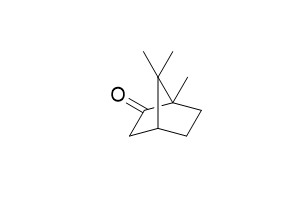(+/-)-Camphor
(+/-)-Camphor could be a repellent compound.
Inquire / Order:
manager@chemfaces.com
Technical Inquiries:
service@chemfaces.com
Tel:
+86-27-84237783
Fax:
+86-27-84254680
Address:
1 Building, No. 83, CheCheng Rd., Wuhan Economic and Technological Development Zone, Wuhan, Hubei 430056, PRC
Providing storage is as stated on the product vial and the vial is kept tightly sealed, the product can be stored for up to
24 months(2-8C).
Wherever possible, you should prepare and use solutions on the same day. However, if you need to make up stock solutions in advance, we recommend that you store the solution as aliquots in tightly sealed vials at -20C. Generally, these will be useable for up to two weeks. Before use, and prior to opening the vial we recommend that you allow your product to equilibrate to room temperature for at least 1 hour.
Need more advice on solubility, usage and handling? Please email to: service@chemfaces.com
The packaging of the product may have turned upside down during transportation, resulting in the natural compounds adhering to the neck or cap of the vial. take the vial out of its packaging and gently shake to let the compounds fall to the bottom of the vial. for liquid products, centrifuge at 200-500 RPM to gather the liquid at the bottom of the vial. try to avoid loss or contamination during handling.
Metabolites.2023, 13(6):689.
Biochem Biophys Res Commun.2019, 518(4):732-738
Food Chem.2024, 446:138870.
Phytomedicine.2018, 41:62-66
Institute of Food Science & Technology2021, 18 December.
Arch Biochem Biophys.2020, 687:108384.
Phys Chem Chem Phys.2018, 20(23):15986-15994
J Colloid Interface Sci.2024, 662:760-773.
Progress In Microbes & Molecular Biology2025, 8,1:a0000470.
Foods.2022, 11(6):882.
Related and Featured Products
Journal of Chemical Ecology,1985,11:1297–1306.
Isolation and identification of mosquito repellents inArtemisia vulgaris.[Reference:
WebLink]
The mugwortArtemisia vulgaris L. (Compositae: Anthemideae) contains insect repellents which can be released from the plant tissues by combustion.
METHODS AND RESULTS:
Work was carried out to isolate and identify the repellent compounds. The dried, pulverized whole plants were steam-distilled to give a repellent essential oil which was fractionated by column chromatography. Active fractions were analyzed by capillary GC and by combined GC-MS. A number of compounds, mainly monoterpenoids, were identified. When tested as repellents against the yellow fever mosquitoAedes aegypti L. (Diptera: Culicidae), (±)-linalool, (±)-camphor((+/-)-Camphor), (+)-camphor, (−)-camphor, isoborneol, (−)-borneol, terpinen-4-ol, and isobornyl acetate were active at 0.14 mg/cm2 or higher. Nonanone-3, (α+β)-thujone, and bornyl acetate were active at 0.28 mg/cm2 or higher. β-Pinene, myrcene, α-terpinene, (+)− limonene, and cineole were active at 1.4 mg/cm2.
CONCLUSIONS:
Of the repellent compounds identified, terpinen-4-ol was the most active and was as effective as dimethyl phthalate.
Mutat Res, 1998, 416(1-2):129-136.
Mutagenicity testing of (±)-camphor, 1,8-cineole, citral, citronellal, (−)-menthol and terpineol with the Salmonella/microsome assay.[Reference:
WebLink]
The essential oils and their monoterpenoid constituents have been widely used as fragrances in cosmetics, as flavouring food additives, as scenting agents in a variety of household products, as active ingredients in some old drugs, and as intermediates in the synthesis of perfume chemicals.
METHODS AND RESULTS:
The present study was undertaken to investigate the mutagenic potential of six monoterpenoid compounds: two aldehydes (citral and citronellal), a ketone ((+/-)-Camphor), an oxide (1,8-cineole, also known as eucalyptol), and two alcohols (terpineol and (−)-menthol). It is part of a more comprehensive toxicological screening of monoterpenes under way at our laboratory. Mutagenicity was evaluated by the Salmonella/microsome assay (TA97a, TA98, TA100 and TA102 tester strains), without and with addition of an extrinsic metabolic activation system (lyophilized rat liver S9 fraction induced by Aroclor 1254). In all cases, the upper limit of the dose interval tested was either the highest non-toxic dose or the lowest dose of the monoterpene toxic to TA100 strain in the preliminary toxicity test. No mutagenic effect was found with (+/-)-Camphor, citral, citronellal, 1,8-cineole, and (−)-menthol. Terpineol caused a slight but dose-related increase in the number of his revertants with TA102 tester strain both without and with addition of S9 mixture.
CONCLUSIONS:
The results from this study therefore suggest that, with the exception of terpineol, the monoterpenoid compounds tested are not mutagenic in the Ames test.
Polymer International,1997, 42(4):385-392.
Preparation and Characterization of Polymer‐dispersed Liquid Crystal Films Using Poly(bornyl methacrylate)[Reference:
WebLink]
Chiral (+)-bornyl methacrylate and achiral (±)-bornyl methacrylate were synthesized from (+)-camphor and (+/-)-Camphor, respectively.
METHODS AND RESULTS:
To investigate the influence of the steric environment of the chiral polymers on the electro-optical characteristics of polymer-dispersed liquid crystal (PDLC) films, a commercially available positive nematic liquid crystal E7 was dispersed in the chiral and achiral polymer matrices. The electro-optical characteristics and the microstructures of the PDLC films with chiral and achiral racemized polymers were investigated.
CONCLUSIONS:
It was found that PDLC films with chiral polymers have relatively high contrast ratio and fast falling speed, but there exists a transient damping response when a square pulse of 20ms and 60V is applied.
Two distinct morphologies were observed: (1) a ‘continual channel’ with the chiral polymer matrix, and (2) an ‘isolated ball’ with the achiral racemized polymer matrix. The reversible turbid and transparent changes with an applied a.c. electric field were also investigated.



